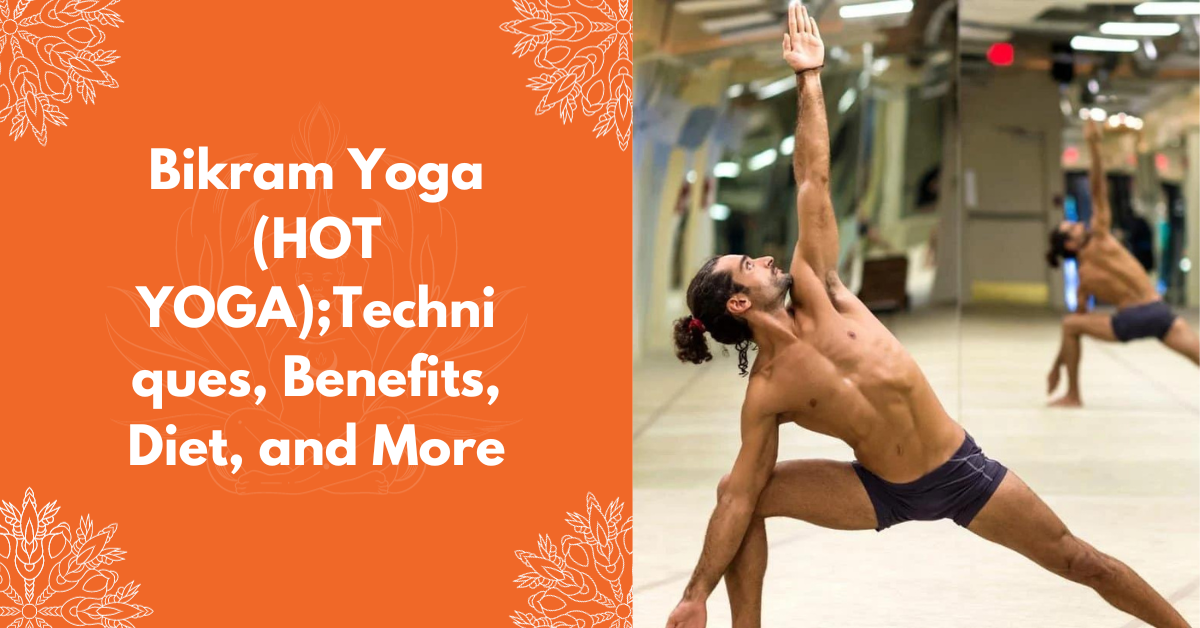
Bikram Yoga (HOT YOGA);Techniques, Benefits, Diet, and More
“🔥 Discover the Ultimate Bikram Yoga Experience! 🔥 Unleash Your Inner Warrior with Hot Yoga in Just 90 Minutes. Get Started Now!”
Bikram Yoga (HOT YOGA),has gained immense popularity over the years for its unique combination of yoga poses and high-temperature conditions.
Founded by Bikram Choudhury in the 1970s, this practice consists of a series of 26 postures and two breathing exercises performed in a room heated to around 105°F (40°C) with a humidity level of 40%.
1. What is Bikram Yoga (HOT YOGA)?
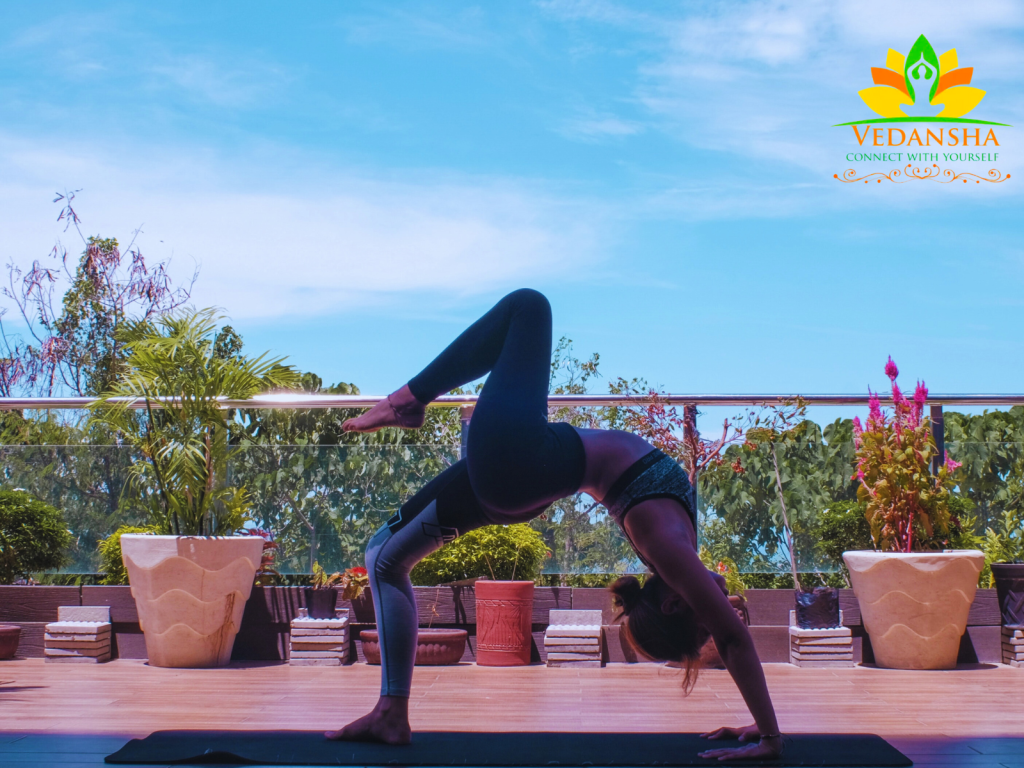
A Brief History
Bikram Yoga was developed by Bikram Choudhury, an Indian yoga guru, in the 1970s. It was designed to provide a comprehensive workout in a heated room to facilitate deep stretching, increased flexibility, and detoxification. The practice gained popularity due to its unique combination of yoga poses and hot, humid conditions.
The Hot Yoga Experience
In a Bikram Yoga class, participants perform a sequence of 26 postures and two breathing exercises over the course of 90 minutes. The high temperature and humidity levels are believed to help the body detoxify, increase circulation, and improve flexibility. The goal is to build strength, enhance balance, and reduce stress.
2. How to Do Bikram Yoga: Step-by-Step
Preparing for Class
Before you step into a Bikram Yoga class, here are some essential preparations:
- Hydrate: Drink plenty of water throughout the day leading up to your class to ensure you’re well-hydrated. You’ll sweat a lot during the session, so staying hydrated is crucial.
- Appropriate Clothing: Wear light, breathable, and moisture-wicking clothing. Avoid heavy materials that can trap sweat.
- Yoga Mat and Towel: Bring a non-slip yoga mat and a towel to place on your mat. You’ll sweat a lot, and the towel will help with grip and absorption.
- Arrive Early: Arriving at least 15 minutes early allows you to acclimate to the heat and settle into the environment.
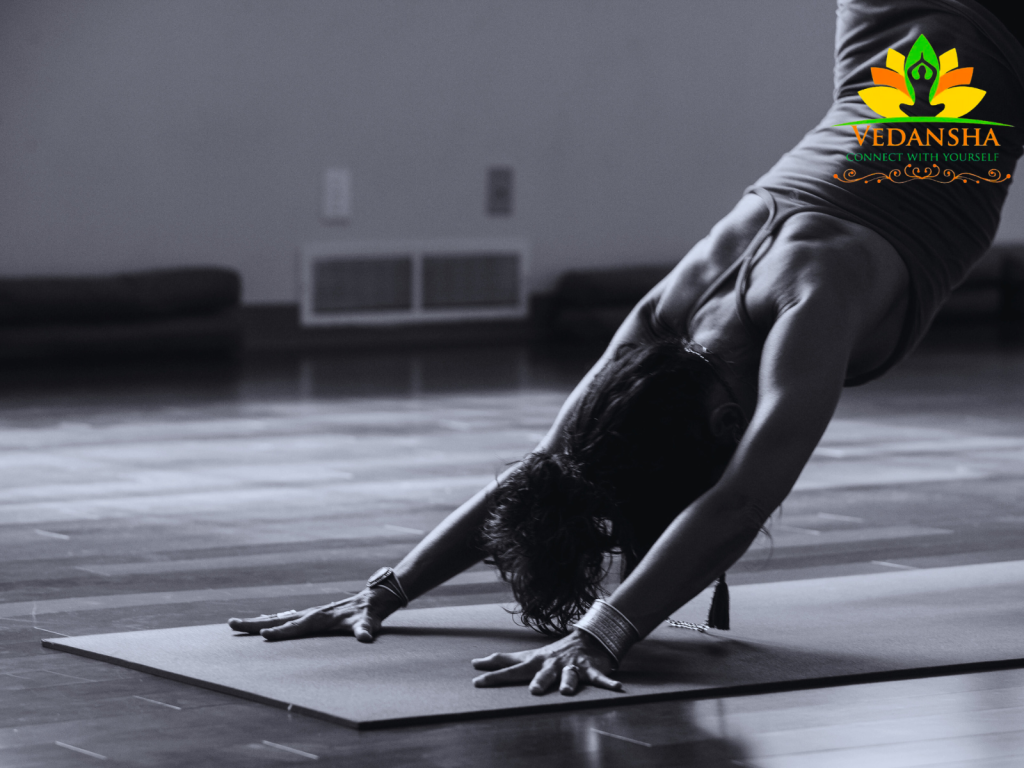
Postures and Breathing Exercises
The sequence of exercises in Bikram Yoga is carefully designed to work every part of the body. Here’s a brief overview:
Breathing Exercises
- Pranayama Series: Pranayama consists of two breathing exercises to help improve lung capacity and prepare the body for the physical postures.
Standing Series (Postures 1-12)
- Standing Deep Breathing: A deep, controlled breath while standing.
- Half Moon Pose: A side-stretching posture.
- Awkward Pose: Three variations of squats.
- Eagle Pose: A balancing posture.
- Standing Head-to-Knee Pose: A forward-bending posture.
- Standing Bow Pose: A back-bending posture.
- Balancing Stick Pose: A full-body stretching posture.
- Standing Separate Leg Stretching Pose: A wide-legged forward bend.
- Triangle Pose: A lateral stretch.
- Standing Separate Leg Head-to-Knee Pose: A forward-bending posture.
- Tree Pose: A balancing posture.
- Toe Stand Pose: A balance and flexibility posture.
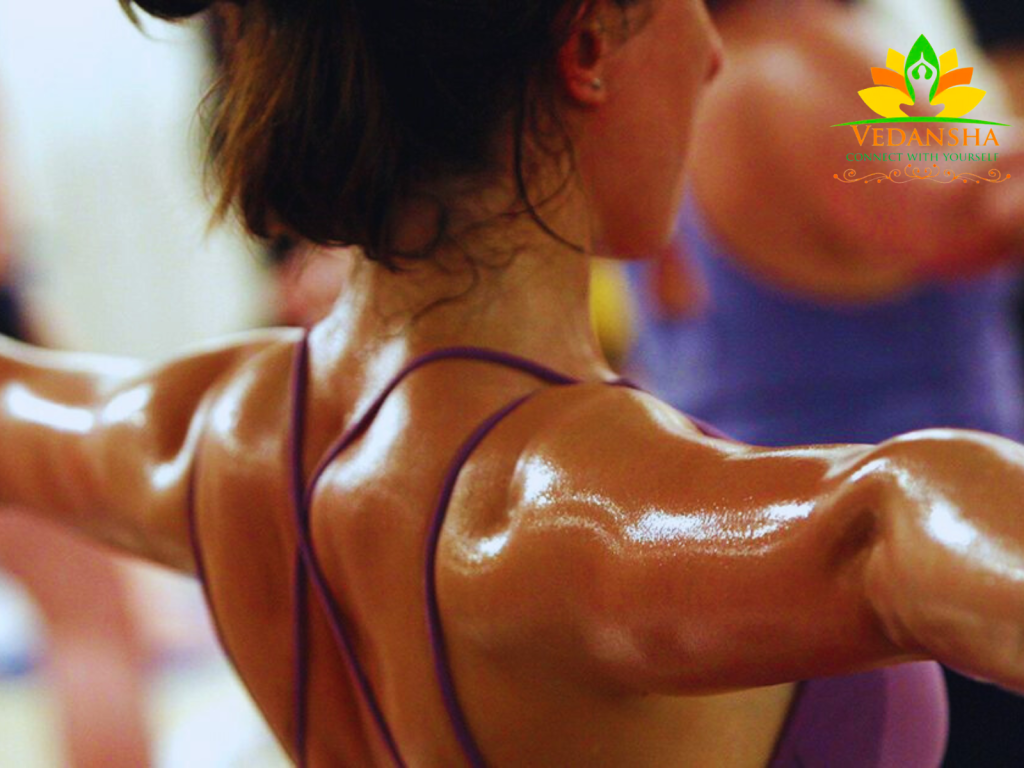
Floor Series (Postures 13-26)
- Dead Body Pose: A relaxation pose.
- Wind Removing Pose: A compression and stretching posture.
- Sit-Up: Abdominal strengthening.
- Cobra Pose: A back-bending posture.
- Locust Pose: Strengthens the lower back.
- Full Locust Pose: A full-body strengthening posture.
- Bow Pose: A back-bending posture.
- Fixed Firm Pose: A knee and hip flexor stretch.
- Half Tortoise Pose: A forward-bending stretch.
- Camel Pose: A deep backbend.
- Rabbit Pose: A forward-bending posture.
- Head to Knee Pose with Stretching Pose: A forward bend and stretching posture.
- Spine Twisting Pose: A spinal twist.
- Savasana: Final relaxation.
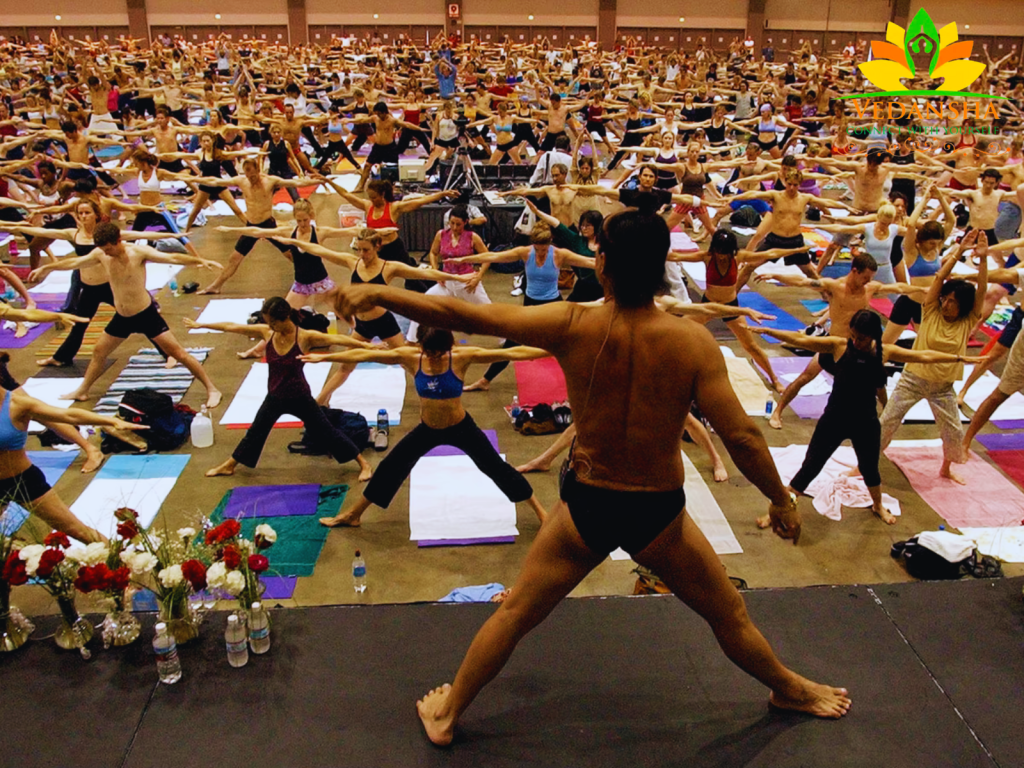
3. Tips and Precautions for Bikram Yoga
Hydration is Key
- Drink water before, during (if needed), and after your Bikram Yoga session. Dehydration can lead to fatigue and dizziness in the hot environment.
Dress Comfortably
- Choose moisture-wicking and breathable clothing that allows you to move freely. Avoid heavy fabrics.
Listen to Your Body
- It’s essential to pay attention to your body’s signals during the practice. If a posture feels painful or too challenging, modify it or take a break.
4. Techniques for a Successful Bikram Yoga Practice
Proper Breathing
- Focus on deep and controlled breathing throughout the practice. Breathing helps you stay calm and centered, even in challenging postures.
Focus on Alignment
- Correct alignment is crucial in Bikram Yoga to prevent injury and maximize the benefits of each posture. Listen to your instructor’s cues for alignment guidance.
Consistency is Key
- Bikram Yoga is most effective when practiced regularly. Aim for consistency in your practice to experience the full range of benefits.
5. Benefits of Bikram Yoga
Physical Benefits
- Improved flexibility: The heat allows for deeper stretching, enhancing your overall flexibility.
- Increased strength: Many postures require muscular effort, helping to build strength.
- Detoxification: Sweating helps remove toxins from the body.
- Weight loss: Regular practice can aid in weight management.
- Enhanced circulation: The heat promotes better blood flow.
Mental and Emotional Benefits
- Stress reduction: Bikram Yoga can help calm the mind and reduce stress.
- Improved focus: The practice encourages mindfulness and concentration.
- Better sleep: Many practitioners report improved sleep patterns.
Improved Flexibility
- The heat in Bikram Yoga makes it easier to stretch and improve your range of motion. Over time, you’ll notice increased flexibility in your muscles and joints.
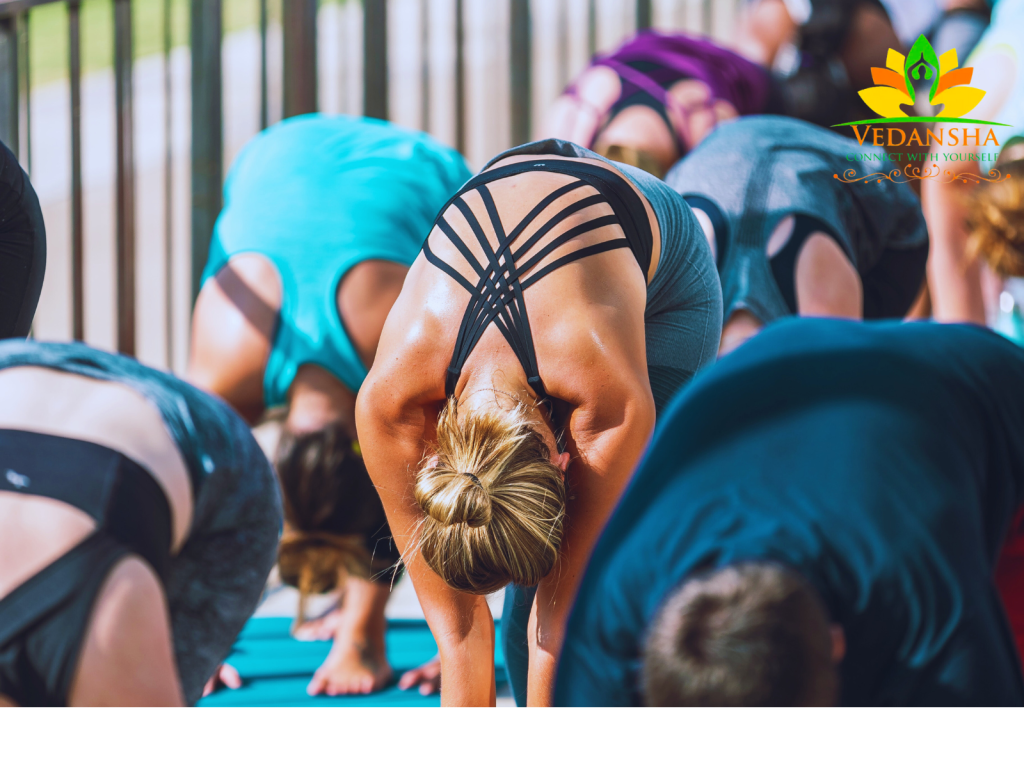
6. Diet Plan for Bikram Yoga Practitioners
Morning Nutrition
- Start your day with a glass of warm water and lemon to aid digestion.
- Opt for a balanced breakfast with a mix of carbohydrates, protein, and healthy fats. Consider options like oatmeal with fruits and nuts or a smoothie with spinach, banana, and protein powder.
Lunch Ideas
- Choose a light and balanced lunch to fuel your afternoon.
- Examples include a quinoa salad with vegetables and grilled chicken or a vegetable stir-fry with tofu and brown rice.
Evening Meals
- In the evening, opt for a well-rounded dinner.
- Consider baked salmon with steamed broccoli and quinoa or a lentil and vegetable stew.
7. Foods to Avoid
Avoiding certain foods before practicing Bikram Yoga can help prevent discomfort and promote a better yoga experience. Here are some foods to steer clear of before your Bikram Yoga session:
- Heavy, Greasy, or Fried Foods: These can make you feel sluggish and uncomfortable during your practice. Foods like burgers, fries, and deep-fried items are best avoided.
- Large Meals: Eating a big meal shortly before your Bikram Yoga class can lead to digestive discomfort and may hinder your ability to perform comfortably. It’s better to have a light meal or snack a few hours before your practice.
- Spicy Foods: Spicy foods can increase your body temperature and may cause discomfort in the heated room. Avoid spicy dishes like hot curries or chili peppers.
- Carbonated Drinks: Carbonated beverages can lead to bloating and discomfort. Stick to water or herbal teas to stay hydrated.
- Alcohol: Consuming alcohol before a Bikram Yoga class can lead to dehydration, which is exacerbated by the heat and humidity in the room.
- High Sugar Foods: Foods and drinks high in sugar can cause energy spikes and crashes, which can be particularly disruptive during a yoga session.
- Dairy Products: For some people, dairy products can lead to digestive discomfort and bloating. If you’re sensitive to dairy, it’s best to avoid it before your practice.
8. Conclusion
Bikram Yoga, or Hot Yoga, offers a unique and challenging yoga experience that combines physical postures with a heated room to promote flexibility, strength, and overall well-being. By following proper techniques, staying hydrated, and maintaining a balanced diet, you can make the most of your Bikram Yoga practice.
Remember that consistency is key, and with time and dedication, you can unlock the numerous physical and mental benefits this practice has to offer. So, roll out your yoga mat, embrace the heat, and embark on your journey to a healthier, more flexible, and stress-free life through Bikram Yoga.
9. Frequently Asked Questions (FAQs)
1. Is Bikram Yoga suitable for beginners?
- Yes, Bikram Yoga can be practiced by beginners. However, it’s essential to start slow, listen to your body, and not push yourself too hard in the beginning.
2. How hot is a Bikram Yoga class?
- Bikram Yoga classes are typically conducted in a room heated to around 105°F (40°C) with a humidity level of 40%.
3. Can Bikram Yoga help with weight loss?
- Regular Bikram Yoga practice, combined with a balanced diet, can aid in weight management and promote weight loss over time.
4. What should I bring to a Bikram Yoga class?
- Bring a yoga mat, a non-slip towel to place on your mat, and plenty of water to stay hydrated.
5. How often should I practice Bikram Yoga?
- Aim to practice Bikram Yoga at least three times a week to experience the full range of benefits. However, consistency is more important than frequency, so find a schedule that works for you.
Now that you have a comprehensive understanding of Bikram Yoga, it’s time to roll out your mat, embrace the heat, and embark on your journey to a healthier, more flexible, and stress-free life through this transformative practice. Namaste!

